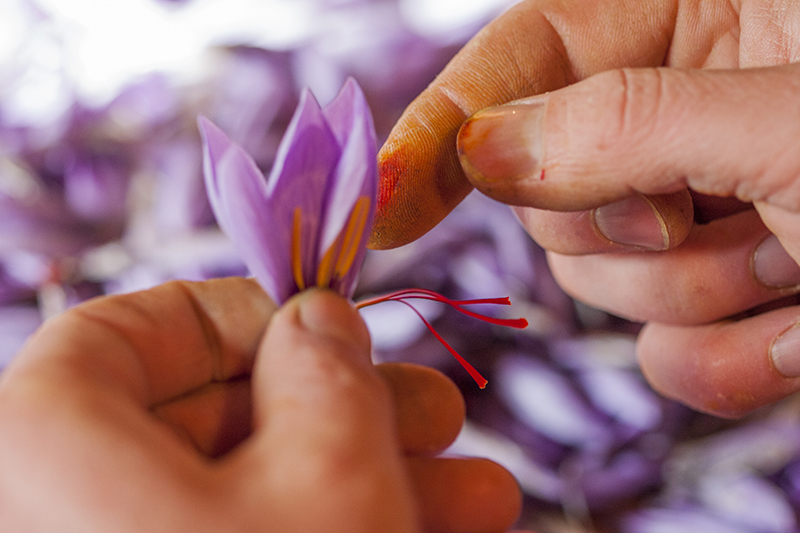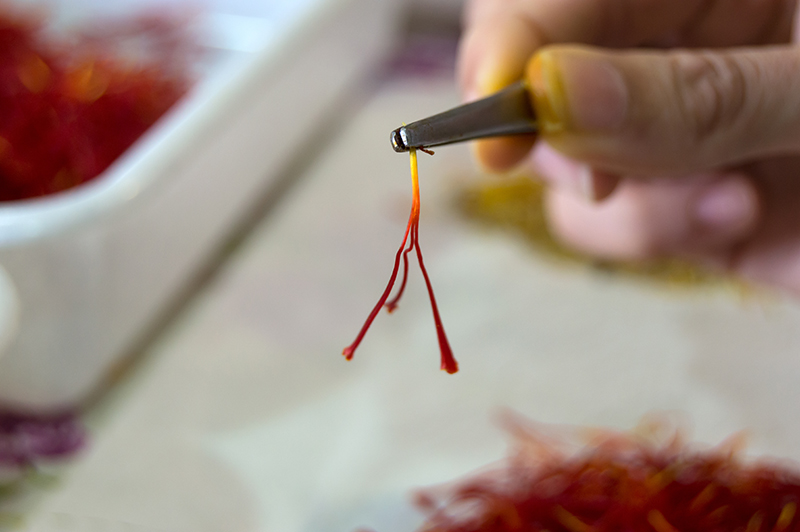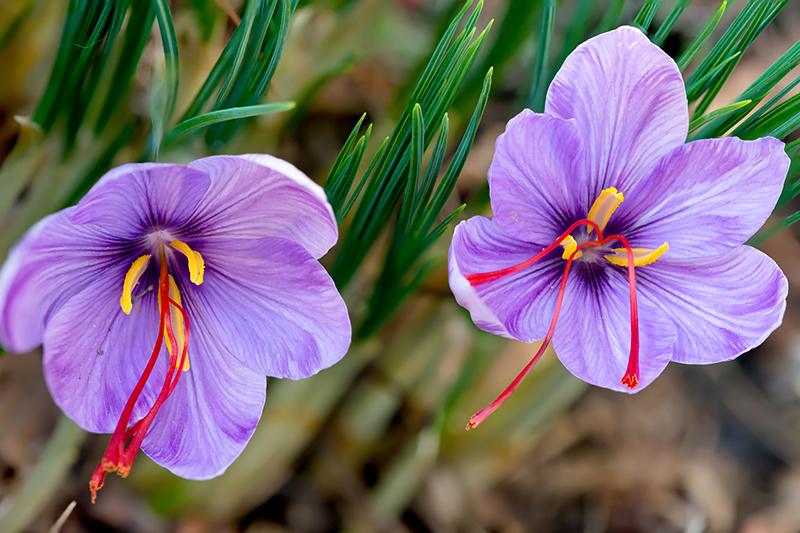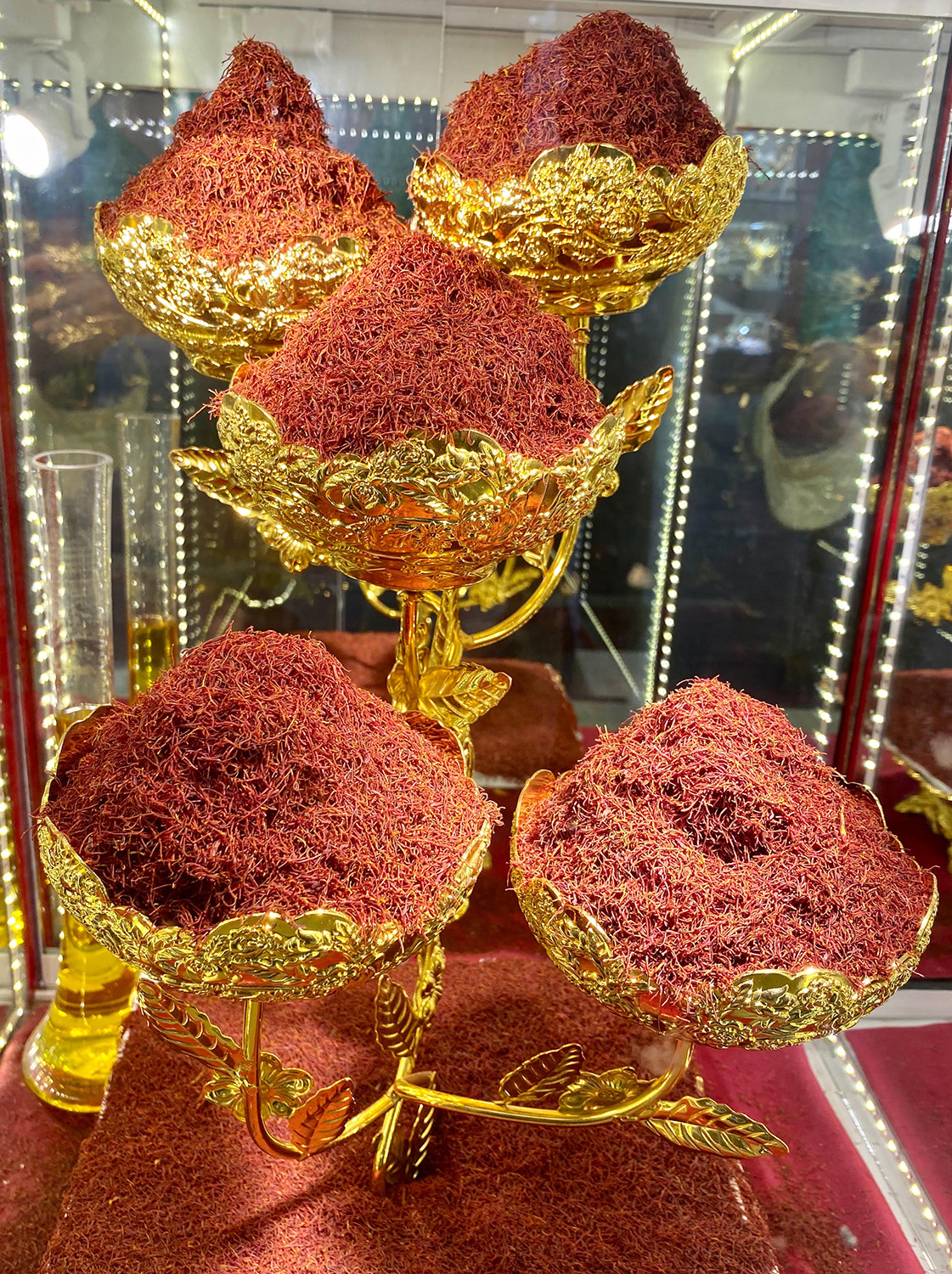Recently Lesley and I toured Jerusalem and various parts of Arabia featured in the Bible. One of our stops was the country of Oman, where the best quality frankincense grows and has been exported since ancient times along with other desert botanicals myrrh and saffron.
A pound of saffron, which in Arabia is sold as “red gold,” approximates the value of an ounce of real gold. It’s no coincidence that the saffron marketplace is adjacent to the world-famous gold market where million-dollar gold necklaces and other baubles are exhibited and sold in stalls and windows along a narrow walkway. Within a half block or so, these extravagant displays yielded to fragrant and colorful stores of saffron.
The herb saffron is the stigmas of the autumn crocus (Crocus sativus), a member of the Iridaceae family. Its extraordinary value is related to the labor-intensive cost of harvesting. Saffron is usually grown in desert areas where drought is common, requiring extra effort to provide irrigation. Each plant which grows from a bulb may produce from one to seven flowers. There are only three stigmas per flower and these must be individually plucked by hand. It is estimated that it takes about 200,000 saffron stigmas from 70,000 crocus flowers to make only one pound of saffron. The current average cost of a pound of saffron ranges from $500 for low-grade quality to more than $1500, which even at today’s prices is nearly the cost of an ounce of gold.
Because of its cost, it’s no wonder that herbalists seldom use saffron medically. That is changing as the therapeutic uses for saffron for chronic conditions such a cardiovascular disease, Alzheimer’s, cancer, arthritis and respiratory conditions is becoming more widely appreciated. Furthermore, the cost is offset by how little may be actually needed.

Removing saffron stigmas by hand.
Saffron’s effect on the circulatory system
One of the primary functions of saffron is to promote blood circulation. At a normal low dose of 10 to 30 mg daily (a mere pinch), one may not notice anything. Chinese medicine describes herbs that promote blood circulation as herbs to “regulate and move blood,” and these serve the same function as Western blood thinners. The difference is that besides moving blood, saffron has many other properties including detoxification, promoting digestion, relieving pain, calming the mind, antidepression and paradoxically, preventing bleeding.
Saffron and cancer
Saffron is well known to be effective at least as part of a comprehensive treatment of various cancers. Saffron, with its powerful blood moving, immune regulating and antioxidant properties, plays an important role in the herbal treatment of cancer. Blood moving properties of saffron means that it can either slow or prevent metastasis by preventing cancer cells from ‘nesting’ at different sites of the body. Saffron also triggers apoptosis (cancer cell death) in a variety of cancers.
Saffron’s three major bioconstituents – crocin, crocetin, and safranal – have shown powerful apoptosis-inducing properties. Further, saffron has a shown a selective toxicity against cancer cells with crocin being the most valuable anticancer agent and crocetin inhibiting the growth of cancer cells, and with very low toxicity against normal cells.[i]
See Part Two of this series for more on saffron’s use in cancer treatment.
Saffron and Alzheimer’s Disease
Saffron has also proved itself in one study to be as effective as Memantine, a prescription drug, used to slow cognitive decline in Alzheimer’s patients. Like ginkgo, only 20 to 30 mg of saffron increases blood circulation to the brain. When combined with Vitamin E and turmeric it has the ability to prevent and correct the accumulation of amyloid plaque in the brain which is associated with dementia and Alzheimer’s disease. In fact, this study supported the findings of two previous trials on saffron’s effect on mild-to-moderate Alzheimer’s, which suggested that the herb may inhibit the overgrowth of amyloid plaque in the brain.[ii]
Saffron and depression
Current increased consumer popularity of saffron is based on its antidepressant properties[iii]. Several trial screenings over a period of time compared the effects of imipramine (Tofranil) and fluoxetine (Prozac), and citalopram, a selective serotonin reuptake inhibitor (SSRI) popularly known as Celexa, for symptoms of depression.[iv] These studies found no significant differences between saffron and antidepressant drugs in terms of improvements in depressive symptoms. As a result in some circles saffron is popularly known as the “the sunshine herb.” [v]
Saffron and the heart
Improving blood circulation extends the benefit of Saffron use to reduce risk of heart disease and strokes. Besides its mild niacin-like reaction in promoting blood circulation, saffron is rich in minerals like thiamin and riboflavin known for promoting heart health.
Dosage
As to the question of saffron’s high cost, this is offset by the extremely small dose needed for medicine. Of course, dose depends on the condition and individual for whom it might benefit. However, on average a dose of 1-3grams in decoction or 0.5-1.5 mg of the ingested powder or 30 mg of dried extract per days is considered adequate for most conditions.
Confusion regarding toxicity
Saffron taken in appropriate doses is very safe. However reports of toxicity have appeared as a result of it being confused with autumn crocus (Crocus autumnale) which contains the toxic compound colchicum used by doctors to treat gout.
Saffron as a culinary spice
Of course, the most common use for saffron is as an exotic culinary spice. Saffron is used in a wide number of special dishes including French bouillabaisse, Italian risotto Milanese, Spanish paella, Indian biryani, and a host of Persian saffron-infused specialty dishes. In fact, saffron can infuse magic in even the most common foods such as mashed potatoes.
To achieve the full benefit of saffron spice, fortunately it only requires a few of the precious blood-red threads. About a teaspoon of saffron infused in 8 ounces of warm water will yield the right intensity of flavor for most dishes. This liquid is then added to water in which rice, vegetables, meat, vegetable stocks, citrus juice and even alcoholic drinks. Some cooks freeze the infused saffron water into cubes and use as needed.[vi]
Be careful to not use too much as a strong taste of saffron may be disagreeable to some of your guests who are not used to the flavor. A little bit goes a long way.

A close-up of the yellow base of the three red saffron stigmas.
The problem of adulteration of saffron
An herb that has such high value is subject to rampant adulteration. A common error is marketing safflower (Carthamus tinctorius, from whose seeds oil is extracted and commercially sold) as true saffron. The substitution safflower for saffron was used by the early Spanish colonists along the Rio Grande. Safflower petals sold as saffron is properly called “bastard saffron.” While it has blood moving properties, a large amount, up to 30 grams, needs to be used for cardiovascular and menstrual irregularities. It also lacks the complexity of flavor and rich medical healing virtues of true saffron.
Sourcing good quality saffron
First quality saffron called “Nigen” consists of full deep red stamens with a triangular shape at the tips. It should have no yellow at the base of the stamen that connects to the flower. Saffron with some yellow color can also be used but is considered of lesser quality.

Saffron crocus sativus purple flowers
To understand why the red color is important one must visualize the crocus flower. Crocin is the most therapeutically active constituent. High crocin content is determined by the deep red color, the length of the stigmas, the near lack of yellow stamen showing, the fragrance and spicy taste. There are only three tiny red stigma threads for each flower. First the flowers are picked by the bushel. These are then taken to an enclosed area where several people gather around a table and pick off the stigmas individually by hand. Any part of the base yellow that might be remaining is removed. Obviously, this is a labor-intensive job, and a very expensive process.
When purchasing high quality saffron in Oman, one merchant showed me small pieces of red plastic made to look like and adulterate saffron. So as with the purchasing of any medicinal herb, the rule, whenever possible is to “know your source.” Because adulteration and quality of saffron is so important I refer you to this site, which also appears to be a good source for the best quality saffron.
Where is Saffron cultivated?
One can cultivate crocus sativa in the garden. It grows best in Zones 6 through 9 in the West and in full sunlight and well-drained soil with a moderate amount of organic matter in the soil. The bulbs are readily available online for fall planting.
While Iran is the world’s leading supplier of saffron, Afghanistan is the second with Afghani farmers seeking an alternative to poppies used for the opium market for which they are the also the second largest supplier in the world. As a result, Afghanistan has been investing research into saffron’s potential medicinal uses. Saffron is also cultivated in other parts of the world including Spain and Greece.
.
Next week, I’ll go more in depth into saffron’s emerging potential in the treatment of cancer.
[i] https://www.sciencedirect.com/science/article/pii/S2352385915300116
[ii] https://www.nutritionaloutlook.com/brain-health/alzheimers-patients-consume-saffron-year
[iii] https://www.ncbi.nlm.nih.gov/pmc/articles/PMC6266642/
[iv] https://www.ncbi.nlm.nih.gov/pubmed/27595298
[v] https://www.ncbi.nlm.nih.gov/pmc/articles/PMC6266642/
[vi] https://www.thespruceeats.com/cooking-with-saffron-tips-2394983

